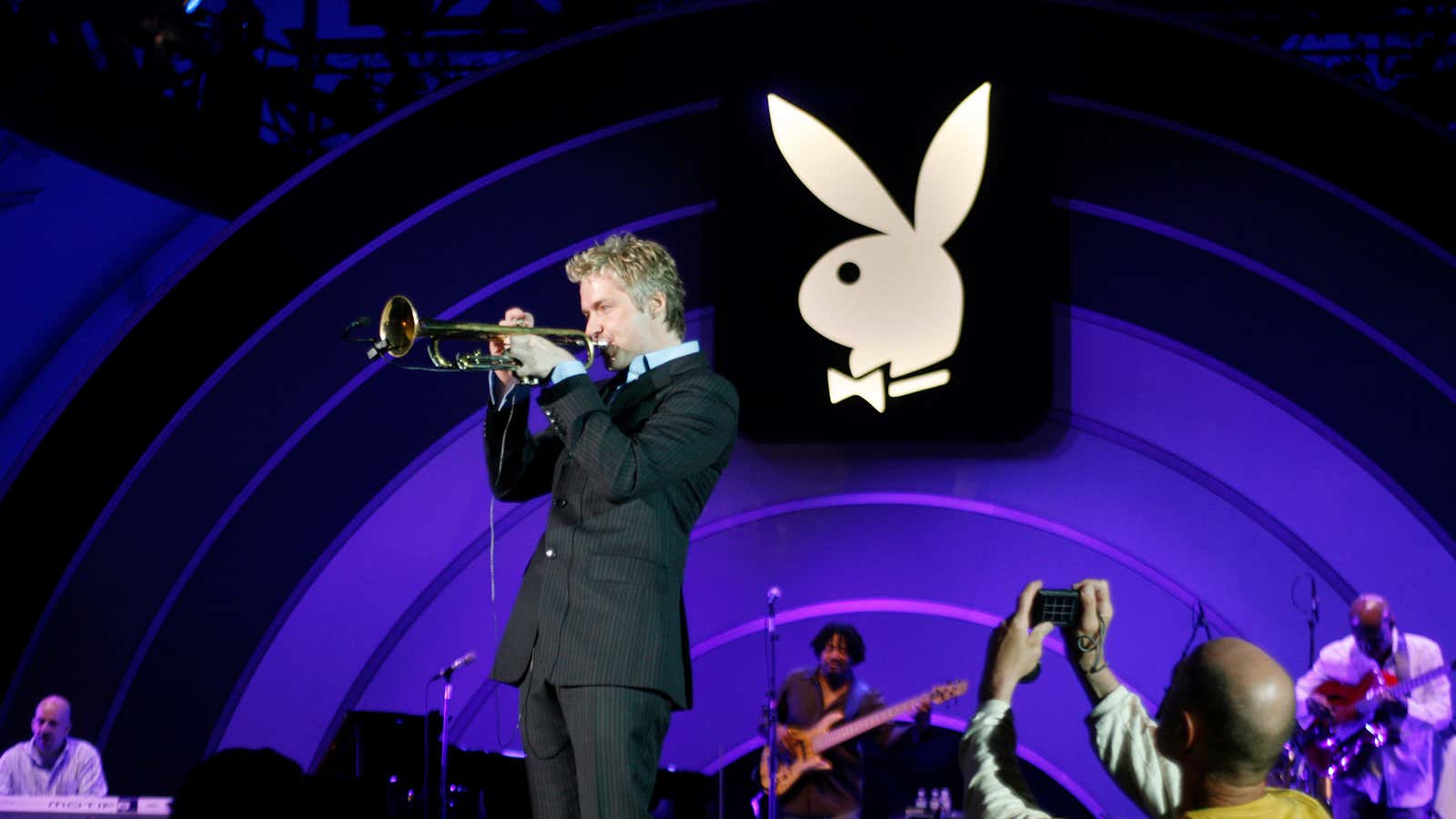When most people think of the Playboy brand, they generally think of sex. This isn’t surprising given that the Playboy magazine, clubs, and ethos are all indelibly linked to images of semi-nude or nude young women—and of course, to the famously un-monogamous lifestyle of Hugh Hefner. Even the word the magazine borrowed for its name means, loosely, some rich guy who sleeps around.
But treating Playboy (full disclosure, for which I freelance) as a one-dimensional brand is reductive. That’s made clear in Patty Farmer and Will Friedwald’s new book, Playboy Swings, a history of the relationship between Playboy and jazz.
For those who think of Playboy only in terms of centerfolds and bunnies, the link to music appreciation may seem surprising. But in fact, as Playboy Swings explains, it’s perfectly in line with Hefner’s overall brand vision. Hefner, the authors say, “started out awkward and unpolished… he saw himself as an average guy who aspired to the higher things in life.” Playboy—both the magazine and the company—was, in a very American way, part of a vast self-help endeavor. For Hefner, Playboy Swings explains, “Attracting the highest class of women… required cultivating one’s taste in literature, music, cuisine, and the rest of the finer things in life.”
Preeminent among those finer things was jazz. Hefner was himself a fan, but he also used the genre to project an air of hipness and suave sophistication, without the more nerdy or pretentious associations of classical. Early on Playboy featured profiles of the Dorsey Brothers (in the first issue), Louis Armstrong, and pianist Dave Brubeck even contributed an article about contemporary jazz. In 1962, this famous Alex Haley magazine interview with Miles Davis inaugurated a series of important conversations with leading black cultural and political figures.
The jazz content worked to create an image of the Playboy reader as smart, cutting edge, and savvy—the sort of person who listened to the right kind of music, and, for that matter, read the right kind of magazine. Jazz helped to cement Playboy’s status as an intellectual and cultural force during this early era especially—a magazine with pictures of attractive women which you could legitimately read for the articles.
If jazz bolstered Playboy’s image, Playboy made numerous contributions to jazz in return. According to Playboy Swings, Playboy was one of the few mainstream publications to regularly review jazz releases. On more than one occasion Hefner paid jazz artists to perform in high profile, respected settings. In 1959, Playboy organized a large-scale jazz festival in Chicago, hosting luminaries like Louis Armstrong, Ella Fitzgerald, the Basie Band, Miles Davis, and the vocal trio Lambert, Hendricks, and Ross. The branded television show, Playboy’s Penthouse hosted by Hefner, also featured many jazz and jazz-tinged pop artists in its short run from 1959-1961, including cabaret singer Mabel Mercer, a relatively little known performer at the time who was a major influence on Frank Sinatra and a Hefner favorite.
Playboy’s clubs, launched in the early 1960s, also became major and potentially lucrative venues for jazz artists. Performers like Dizzy Gillespie, Stan Getz, and Carmen McCrae put in appearances and the important jazz trombonist Kai Winding served as musical director of the New York club for several years.
The interest in jazz also was tied to what is perhaps Playboy’s finest legacy: Hugh Hefner’s principled and consistent support for the black civil rights movement. Playboy’s Penthouse included performances by integrated groups, which seriously limited its broadcast in Southern markets. Hefner actually bought back Playboy club franchises in the South, at considerable expense, when the owners balked at integrating the venues. Comedian Dick Gregory, a regular performer at the clubs, credited Hefner’s commitment to black artists with establishing his career. “Hugh Hefner… believes in humanity,” Gregory is quoted as saying in the book. “He waged a lifelong battle for racial equality.”
For Playboy, then, jazz meant sophistication, cosmopolitanism—and, partially as a result, it also represented a link to progressivism. That’s the upside of fusing art, lifestyle, and aspiration.
Not that there weren’t some darker aspects. Playboy Swings doesn’t deal with these issues directly, but they peer out from around the edges nonetheless. The book includes celebrity images of convicted rapist Roman Polanski, Woody Allen, whose step-daughter accused him of sexually assaulting her when she was a child, and Bill Cosby, who has been accused of rape by more than 40 women.
Cosby, a longtime friend of Hefner, hosted the Playboy jazz festival at the Hollywood Bowl for three decades. He’s also been accused of raping numerous women who worked as bunnies at Playboy clubs and of raping at least one woman at the Playboy mansion. Sophisticated hedonism set to a jazz soundtrack may have meant inclusivity and promoting great art. But it also, at least in Cosby’s case, meant misogyny and sexual assault.
The involvement of Cosby doesn’t invalidate the good Playboy did via its association with jazz, but the good doesn’t exactly erase Cosby either. Playboy Swings is a fun chronicle of music, celebrity, and the show-business world in the 50s, 60s, and 70s. But it’s perhaps most fascinating because of the questions it raises, about what happens, for better and worse, when art becomes lifestyle, and lifestyle becomes art.
